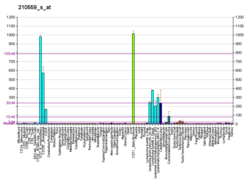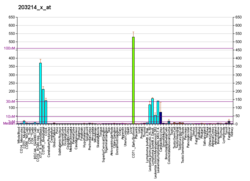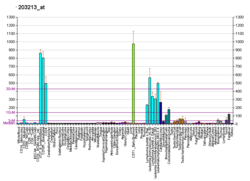Cyclin-dependent kinase 1
Cyclin-dependent kinase 1 also known as CDK1 or cell division cycle protein 2 homolog is a highly conserved protein that functions as a serine/threonine protein kinase, and is a key player in cell cycle regulation. It has been highly studied in the budding yeast S. cerevisiae, and the fission yeast S. pombe, where it is encoded by genes cdc28 and cdc2, respectively. With its cyclin partners, Cdk1 forms complexes that phosphorylate a variety of target substrates (over 75 have been identified in budding yeast); phosphorylation of these proteins leads to cell cycle progression.
Structure
Cdk1 is a small protein (approximately 34 kilodaltons), and is highly conserved. The human homolog of Cdk1, CDK1, shares approximately 63% amino-acid identity with its yeast homolog. Furthermore, human CDK1 is capable of rescuing fission yeast carrying a cdc2 mutation. Cdk1 is comprised mostly by the bare protein kinase motif, which other protein kinases share. Cdk1, like other kinases, contains a cleft in which ATP fits. Substrates of Cdk1 bind near the mouth of the cleft, and Cdk1 residues catalyze the covalent bonding of the γ-phosphate to the oxygen of the hydroxyl serine/threonine of the substrate.
In addition to this catalytic core, Cdk1, like other cyclin-dependent kinases, contains a T-loop, which, in the absence of an interacting cyclin, prevents substrate binding to the Cdk1 active site. Cdk1 also contains a PSTAIRE helix, which, upon cyclin binding, moves and rearranges the active site, facilitating Cdk1 kinase activities.
Function
When bound to its cyclin partners, Cdk1 phosphorylation leads to cell cycle progression. Cdk1 activity is best understood in S. cerevisiae, so Cdk1 S. cerevisiae activity is described here.
In the budding yeast, initial cell cycle entry is controlled by two regulatory complexes, SBF (SCB-binding factor) and MBF (MCB-binding factor). These two complexes control G1/S gene transcription; however, they are normally inactive. SBF is inhibited by the protein Whi5; however, when phosphorylated by Cln3-Cdk1, Whi5 is ejected from the nucleus, allowing for transcription of the G1/S regulon, which includes the G1/S cyclins Cln1,2. G1/S cyclin-Cdk1 activity leads to preparation for S phase entry (e.g., duplication of centromeres or the spindle pole body), and a rise in the S cyclins (Clb5,6 in S. cerevisiae). Clb5,6-Cdk1 complexes directly lead to replication origin initiation; however, they are inhibited by Sic1, preventing premature S phase initiation.
Cln1,2 and/or Clb5,6-Cdk1 complex activity leads to a sudden drop in Sic1 levels, allowing for coherent S phase entry. Finally, phosphorylation by M cyclins (e.g., Clb1, 2, 3 and 4) in complex with Cdk1 leads to spindle assembly and sister chromatid alignment. Cdk1 phosphorylation also leads to the activation of the ubiquitin-protein ligase APCCdc20, an activation which allows for chromatid segregation and, furthermore, degradation of M-phase cyclins. This destruction of M cyclins leads to the final events of mitosis (e.g., spindle disassembly, mitotic exit).
Regulation
Given its essential role in cell cycle progression, Cdk1 is highly regulated. Most obviously, Cdk1 is regulated by its binding with its cyclin partners. Cyclin binding alters access to the active site of Cdk1, allowing for Cdk1 activity; furthermore, cyclins impart specificity to Cdk1 activity. At least some cyclins contain a hydrophobic patch which may directly interact with substrates, conferring target specificity. Furthermore, cyclins can target Cdk1 to particular subcellular locations.
In addition to regulation by cyclins, Cdk1 is regulated by phosphorylation. A conserved tyrosine (Tyr15 in humans) leads to inhibition of Cdk1; this phosphorylation is thought to alter ATP orientation, preventing efficient kinase activity. In S. pombe, for example, incomplete DNA synthesis may lead to stabilization of this phosphorylation, preventing mitotic progression.Wee1, conserved among all eukaryotes phosphorylates Tyr15, whereas members of the Cdc25 family are phosphatases, counteracting this activity. The balance between the two is thought to help govern cell cycle progression. Wee1 is controlled upstream by Cdr1, Cdr2, and Pom1.
Cdk1-cyclin complexes are also governed by direct binding of Cdk inhibitor proteins (CKIs). One such protein, already discussed, is Sic1. Sic1 is a stoichiometric inhibitor that binds directly to Clb5,6-Cdk1 complexes. Multisite phosphorylation, by Cdk1-Cln1/2, of Sic1 is thought to time Sic1 ubiquitination and destruction, and by extension, the timing of S-phase entry. Only until Sic1 inhibition is overcome can Clb5,6 activity occur and S phase initiation may begin.
Interactions
Cdk1 has been shown to interact with:
See also
Mastl
Further reading
- Draetta G, Eckstein J (1997). "Cdc25 protein phosphatases in cell proliferation". Biochim. Biophys. Acta. 1332 (2): M53–63. doi:10.1016/S0304-419X(96)00049-2. PMID 9141461.
- Kino T, Pavlakis GN (2004). "Partner molecules of accessory protein Vpr of the human immunodeficiency virus type 1". DNA Cell Biol. 23 (4): 193–205. doi:10.1089/104454904773819789. PMID 15142377.
- Kino T, Chrousos GP (2004). "Human immunodeficiency virus type-1 accessory protein Vpr: a causative agent of the AIDS-related insulin resistance/lipodystrophy syndrome?". Ann. N. Y. Acad. Sci. 1024 (1): 153–167. Bibcode:2004NYASA1024..153K. doi:10.1196/annals.1321.013. PMID 15265780. S2CID 23655886.
- Zhao LJ, Zhu H (2005). "Structure and function of HIV-1 auxiliary regulatory protein Vpr: novel clues to drug design". Curr. Drug Targets Immune Endocr. Metabol. Disord. 4 (4): 265–275. doi:10.2174/1568008043339668. PMID 15578977.
- Le Rouzic E, Benichou S (2006). "The Vpr protein from HIV-1: distinct roles along the viral life cycle". Retrovirology. 2: 11. doi:10.1186/1742-4690-2-11. PMC 554975. PMID 15725353.
- Zhao RY, Elder RT (2005). "Viral infections and cell cycle G2/M regulation". Cell Res. 15 (3): 143–149. doi:10.1038/sj.cr.7290279. PMID 15780175.
- Zhao RY, Bukrinsky M, Elder RT (2005). "HIV-1 viral protein R (Vpr) & host cellular responses". Indian J. Med. Res. 121 (4): 270–86. PMID 15817944.
- Kaldis P, Aleem E (2007). "Cell cycle sibling rivalry: Cdc2 vs. Cdk2". Cell Cycle. 4 (11): 1491–1494. doi:10.4161/cc.4.11.2124. PMID 16258277.
- Li L, Li HS, Pauza CD, Bukrinsky M, Zhao RY (2006). "Roles of HIV-1 auxiliary proteins in viral pathogenesis and host-pathogen interactions". Cell Res. 15 (11–12): 923–934. doi:10.1038/sj.cr.7290370. PMID 16354571.
- Rietbrock N, Keller F (1977). "[Biologic availability and "1st pass" effect of drugs]". Fortschr. Med. 95 (28): 1765–6, 1774–80. PMID 914146.
- Azzi L, Meijer L, Reed SI, Pidikiti R, Tung HY (1992). "Interaction between the cell-cycle-control proteins p34cdc2 and p9CKShs2. Evidence for two cooperative binding domains in p9CKShs2". Eur. J. Biochem. 203 (3): 353–360. doi:10.1111/j.1432-1033.1992.tb16557.x. PMID 1310466.
- Dutta A, Stillman B (1992). "cdc2 family kinases phosphorylate a human cell DNA replication factor, RPA, and activate DNA replication". EMBO J. 11 (6): 2189–99. doi:10.1002/j.1460-2075.1992.tb05278.x. PMC 556686. PMID 1318195.
- Koff A, Giordano A, Desai D, Yamashita K, Harper JW, Elledge S, Nishimoto T, Morgan DO, Franza BR, Roberts JM (1992). "Formation and activation of a cyclin E-cdk2 complex during the G1 phase of the human cell cycle". Science. 257 (5077): 1689–1694. Bibcode:1992Sci...257.1689K. doi:10.1126/science.1388288. PMID 1388288.
- Russo GL, Vandenberg MT, Yu IJ, Bae YS, Franza BR, Marshak DR (1992). "Casein kinase II phosphorylates p34cdc2 kinase in G1 phase of the HeLa cell division cycle". J. Biol. Chem. 267 (28): 20317–25. doi:10.1016/S0021-9258(19)88704-5. PMID 1400350.
- Rubinfeld B, Crosier WJ, Albert I, Conroy L, Clark R, McCormick F, Polakis P (1992). "Localization of the rap1GAP catalytic domain and sites of phosphorylation by mutational analysis". Mol. Cell. Biol. 12 (10): 4634–42. doi:10.1128/MCB.12.10.4634. PMC 360390. PMID 1406653.
- van der Sluijs P, Hull M, Huber LA, Mâle P, Goud B, Mellman I (1992). "Reversible phosphorylation--dephosphorylation determines the localization of rab4 during the cell cycle". EMBO J. 11 (12): 4379–89. doi:10.1002/j.1460-2075.1992.tb05538.x. PMC 557012. PMID 1425574.
- Seth A, Alvarez E, Gupta S, Davis RJ (1992). "A phosphorylation site located in the NH2-terminal domain of c-Myc increases transactivation of gene expression". J. Biol. Chem. 266 (35): 23521–4. doi:10.1016/S0021-9258(18)54312-X. PMID 1748630.
- Lees JA, Buchkovich KJ, Marshak DR, Anderson CW, Harlow E (1992). "The retinoblastoma protein is phosphorylated on multiple sites by human cdc2". EMBO J. 10 (13): 4279–90. doi:10.1002/j.1460-2075.1991.tb05006.x. PMC 453181. PMID 1756735.
- Nazarenko SA, Ostroverhova NV, Spurr NK (1991). "Regional assignment of the human cell cycle control gene CDC2 to chromosome 10q21 by in situ hybridization". Hum. Genet. 87 (5): 621–2. doi:10.1007/BF00209025. PMID 1916766. S2CID 25673088.
- Nissen MS, Langan TA, Reeves R (1991). "Phosphorylation by cdc2 kinase modulates DNA binding activity of high mobility group I nonhistone chromatin protein". J. Biol. Chem. 266 (30): 19945–52. doi:10.1016/S0021-9258(18)54874-2. PMID 1939057.
External links
- Overview of all the structural information available in the PDB for UniProt: P06493 (Cyclin-dependent kinase 1) at the PDBe-KB.
| Cyclin | |||||||||
|---|---|---|---|---|---|---|---|---|---|
| CDK | |||||||||
| CDK inhibitor | |||||||||
| P53 p63 p73 family | |||||||||
| Other | |||||||||
| Phases and checkpoints |
|
||||||||
| |||||||||||||||||||||||||||||||||||||||||||||||
| |||||||||||||||||||||||||||||||||||||||||||||||
| |||||||||||||||||||||||||||||||||||||||||||||||
| Activity | |
|---|---|
| Regulation | |
| Classification | |
| Kinetics | |
| Types |
|










